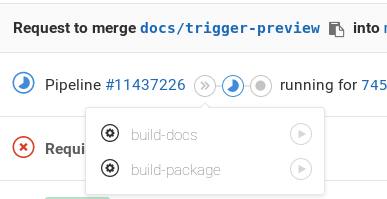Writing documentation
- General Documentation: written by the developers responsible by creating features. Should be submitted in the same merge request containing code. Feature proposals (by GitLab contributors) should also be accompanied by its respective documentation. They can be later improved by PMs and Technical Writers.
- Technical Articles: written by any GitLab Team member, GitLab contributors, or Community Writers.
- Indexes per topic: initially prepared by the Technical Writing Team, and kept up-to-date by developers and PMs in the same merge request containing code. They gather all resources for that topic in a single page (user and admin documentation, articles, and third-party docs).
Distinction between General Documentation and Technical Articles
General documentation
General documentation is categorized by User, Admin, and Contributor, and describe what that feature is, what it does, and its available settings.
Technical Articles
Technical articles replace technical content that once lived in the GitLab Blog, where they got out-of-date and weren't easily found.
They are topic-related documentation, written with an user-friendly approach and language, aiming to provide the community with guidance on specific processes to achieve certain objectives.
A technical article guides users and/or admins to achieve certain objectives (within guides and tutorials), or provide an overview of that particular topic or feature (within technical overviews). It can also describe the use, implementation, or integration of third-party tools with GitLab.
They live under doc/articles/article-title/index.md, and their images should be placed under doc/articles/article-title/img/. Find a list of existing technical articles here.
Types of Technical Articles
- User guides: technical content to guide regular users from point A to point B
- Admin guides: technical content to guide administrators of GitLab instances from point A to point B
- Technical Overviews: technical content describing features, solutions, and third-party integrations
- Tutorials: technical content provided step-by-step on how to do things, or how to reach very specific objectives
Understanding guides, tutorials, and technical overviews
Suppose there's a process to go from point A to point B in 5 steps: (A) 1 > 2 > 3 > 4 > 5 (B).
A guide can be understood as a description of certain processes to achieve a particular objective. A guide brings you from A to B describing the characteristics of that process, but not necessarily going over each step. It can mention, for example, steps 2 and 3, but does not necessarily explain how to accomplish them.
A tutorial requires a clear step-by-step guidance to achieve a singular objective. It brings you from A to B, describing precisely all the necessary steps involved in that process, showing each of the 5 steps to go from A to B. It does not only describes steps 2 and 3, but also shows you how to accomplish them.
- Live example (on the blog): Hosting on GitLab.com with GitLab Pages
A technical overview is a description of what a certain feature is, and what it does, but does not walk through the process of how to use it systematically.
- Live example (on the blog): GitLab Workflow, an overview
Special format
Every Technical Article contains, in the very beginning, a blockquote with the following information:
- A reference to the type of article (user guide, admin guide, tech overview, tutorial)
- A reference to the knowledge level expected from the reader to be able to follow through (beginner, intermediate, advanced)
- A reference to the author's name and GitLab.com handle
- A reference of the publication date
> **Article [Type](../../development/writing_documentation.html#types-of-technical-articles):** tutorial ||
> **Level:** intermediary ||
> **Author:** [Name Surname](https://gitlab.com/username) ||
> **Publication date:** AAAA/MM/DDTechnical Articles - Writing Method
Use the writing method defined by the Technical Writing team.
Documentation style guidelines
All the docs follow the same styleguide.
Markdown
Currently GitLab docs use Redcarpet as markdown engine, but there's an open discussion for implementing Kramdown in the near future.
Testing
We try to treat documentation as code, thus have implemented some testing. Currently, the following tests are in place:
-
docs lint: Check that all internal (relative) links work correctly and that all cURL examples in API docs use the full switches.
If your contribution contains only documentation changes, you can speed up the CI process by following some branch naming conventions. You have three choices:
| Branch name | Valid example |
|---|---|
Starting with docs/
|
docs/update-api-issues |
Starting with docs-
|
docs-update-api-issues |
Ending in -docs
|
123-update-api-issues-docs |
If your branch name matches any of the above, it will run only the docs tests. If it doesn't, the whole test suite will run (including docs).
When you submit a merge request to GitLab Community Edition (CE), there is an
additional job called rake ee_compat_check that runs against Enterprise
Edition (EE) and checks if your changes can apply cleanly to the EE codebase.
If that job fails, read the instructions in the job log for what to do next.
Contributors do not need to submit their changes to EE, GitLab Inc. employees
on the other hand need to make sure that their changes apply cleanly to both
CE and EE.
Previewing the changes live
If you want to preview your changes live, you can use the manual build-docs
job in your merge request.
This job will:
- Create a new branch in the gitlab-docs
project named after the scheme:
<CE/EE-branch-slug>-built-from-ce-ee - Trigger a pipeline and build the docs site with your changes
Look for the docs URL at the output of the build-docs job.
Note: Make sure that you always delete the branch of the merge request you were working on. If you don't, the remote docs branch won't be removed either, and the server where the Review Apps are hosted will eventually be out of disk space.
